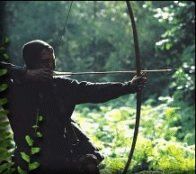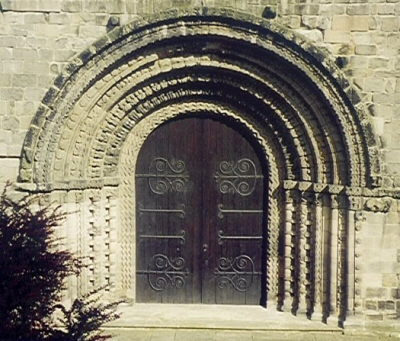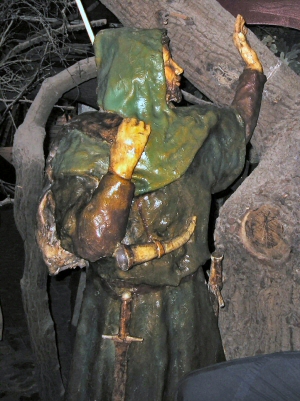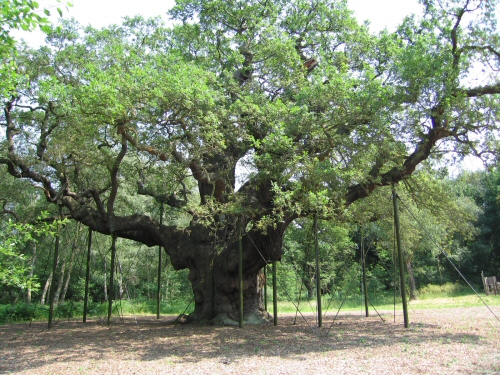Robin Hood
It has always been generally accepted that Maid Marion was the bride of Robin Hood, but if we are to believe an old ballad, written before any mention of Maid Marion, an interesting historical event is revealed.
This ballad is said to have been written either in the fourteenth century or after the time of Elizabeth.
 The
source suggests that Robin married a lady called Clorinda on the fifteenth
of August, sometime during the reign of Henry lll.
The
source suggests that Robin married a lady called Clorinda on the fifteenth
of August, sometime during the reign of Henry lll.
The wedding took place not under the greenwood tree as we might imagine, but in the village of Tutbury, Staffordshire, on the occasion of the annual Bull-running and Musical Festival.
The writer of the ballad is said to have been the King of the Fiddlers, or Musicians, an official appointed annually by the Lord of Tutbury Castle to maintain order among the musicians at the Festival.
In his ballad, the King of the Fiddlers recounts how Robin meets Clorinda, the Queen of the Shepherds, in Needwood Forest, just as she is about to shoot a fat buck. She is dressed appropriately in a green velvet gown, and is wearing high boots, or buskins, which reach to her knee.
She kills the buck and Robin is so impressed with her skill at archery that he proposes marriage to her there and then. She blushes at his offer, and after a pause, which does not appear to have been a very long one, she agrees to accompany him to Tutbury the following day.
In view of the harsh game laws existing at this time, one wonders at the casual way the ballad writer refers to this incident. Clorinda gives her reason for shooting the buck as: "For tomorrow is Tutbury Day." Was she herself perhaps an outlaw, or did her rank as queen of the Shepherds allow her some special privilege?
The happy pair ride off towards Tutbury, and, "before they have gone five Staffordshire miles," as the ballad recites, they meet eight yeomen, who attempt to take the buck away from them. Robin resists their attack and the yeomen are put to flight, and Robin and Clorinda enter Tutbury on the day of the Bull-running.
Bull-running was a cruel mediaeval sport which encouraged bad behaviour and violence among the villagers. The bull had his horns, ears and tail cut off, was smeared with soap, and had his nostrils blown full of pepper. The animal was then let loose in the streets, where the minstrels had the opportunity of trying to catch him. This barbarous custom was eventually abolished after a person was killed during the festivities.
The ballad does not state if Robin tried to join in the Bull-running but merely comments on the scene, "that there was great shouting, the people were staring madly at some who were riding the bull. Others were Morris dancing, and singing, 'Arthur a Bradley'". Later Robin and Clorinda, "with Thomas and Mary, and Ann”, went into dinner. This dinner was usually held in a room at the castle after the election of the King of the Minstrels and his officers.
If, as the ballad suggests, Robin and Clorinda were invited to dinner, why were they not arrested and imprisoned by the Lord of the castle? They seemed to have been very popular, and well received by everybody in Tutbury. During the dinner the assembled guests drank a toast to Clorinda, and informed her that, "Bold Robin Hood was a fine man."
It was decided that the happy pair should be married that day, and a message was sent to Doveridge for Sir Roger, the Parson, to come immediately. He arrived, carrying his Mass book, bade them take hands, and joined them in wedlock with no more ado.
The seeker after truth might be tempted to visit Doveridge to see if Sir Roger is included in the list of incumbents. Sadly, we find no mention of him, but we do see the ancient yew tree under which Robin and Maid Marion are said to have plighted their troth.
Perhaps, as one authority states, Clorinda was just another of Marion's names, but if this is so, it does seem rather odd that they should travel from Doveridge to Tutbury to get married, and then send back to Doveridge for Roger the priest.

One can spend an idle moment on a warm August day standing outside Tutbury church and imagining Robin and his bride emerging through the fine old Norman doorway on their wedding day.
Outside, there would be an excited cheering crowd of musicians and villagers waiting to greet them in the sunshine.
Who was Robin Hood?
 For
many centuries, Nottinghamshire has been the undisputed home of Robin Hood.
For
many centuries, Nottinghamshire has been the undisputed home of Robin Hood.
To give a direct answer to the question: "Who was he?" is difficult. Apart from a few references to be found in medieval chronicles, much of our information is derived from a series of ballads sung in the latter half of the Middle Ages. These were adapted and modified over the next five hundred years until the representation of Robin Hood was quite different.
The first reference to Robin by name is found in "The Vision of Piers Plowman", written by William Langland in 1377. In one verse, a drunken chaplain berates himself for knowing the rhymes of Robin Hood better than he knows his prayers. These rhymes have not survived but they were obviously so well known in Langland's day that he refers to them without explanation.
The oldest ballad to attempt to tell the story of the outlaw band dates from the 15th Century. The "Lytell Geste of Robyn Hode" appears to be a collection of stories which, themselves are derived from much earlier sources.
An example is a 15th Century manuscript from Lincoln Cathedral:
"Robyn Hode in Scherewod stod hodud and hathud, hosuf and schod ffour
and thuyrti arowus he bar in his hondus"
An anonymous manuscript in the British Museum states that he was born in Lockesley in either Yorkshire or Nottinghamshire in 1160. Further references relate to events along the road from York to Nottingham.

The Great Oak in Sherwood Forest - a hiding place?
A birth date in the 12th Century places Robin Hood in the reigns of Richard the Lionheart and his brother John. The costs of providing for the Crusades to the Holy Land had crippled the country's finances and reduced the political structure to chaos. Perhaps the repressed Saxon's were looking for a popular champion and found him in Robin Hood.
If you are interested in Robin Hood, visit the Robin Hood Society Web Page

